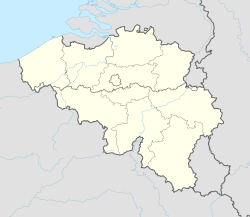Liège
city in Wallonia, Belgium From Wikipedia, the free encyclopedia
Remove ads
Liège (/liˈɛʒ, liˈeɪʒ/ lee-EZH, lee-AYZH,[2][3][4] French: [ljɛʒ] (![]() listen), locally [li.eːʃ]; Walloon: Lidje [liːtʃ]; Dutch: Luik [lœyk] (
listen), locally [li.eːʃ]; Walloon: Lidje [liːtʃ]; Dutch: Luik [lœyk] (![]() listen); German: Lüttich [ˈlʏtɪç]; Latin: Leodium) is a city in Belgium. It is the cultural centre of the Walloon region of Belgium and the capital of the province of Liège. Liège is also seat of a Roman Catholic bishop. In 2007, 188,907 people lived there.[5]
listen); German: Lüttich [ˈlʏtɪç]; Latin: Leodium) is a city in Belgium. It is the cultural centre of the Walloon region of Belgium and the capital of the province of Liège. Liège is also seat of a Roman Catholic bishop. In 2007, 188,907 people lived there.[5]

Liège and the new train station
It is at 50° 38 North, 05° 34 East.[6]
The first written trace of the city was found in 558 as Leodicum or Vicus Leodicus. From 717, Liege was made the seat of a bishopric and became a cultural centre in the Middle Ages. These bishops ruled the city as Prince-Bishops until the 1790s. In the French Revolution, the cathedral was damaged, partially burned down and then completely destroyed. In the 19th century, the city lived on coal-mining, steel industry and trade. The region was the second biggest economic center in Europe after the UK in the 19th century.
Today Liege is a major educational hub, with a university and many high schools. It is a crossing point in Europe, Liège has the second biggest inner harbour and the 8th biggest cargo airport in Europe (Liège Airport). The city, that had a lot of problems since the 1970s because of the end of the steel industry and coal-mining, is now having a good economy thanks to the logistics and high tech industry (biotechnology, space industry, IT).
Remove ads
References
Other websites
Wikiwand - on
Seamless Wikipedia browsing. On steroids.
Remove ads





